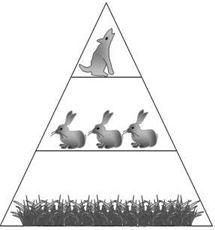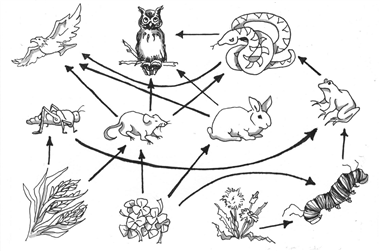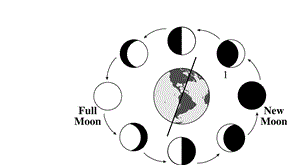Ultimate Quiz On EcoSystems
- 1.
The Sun provides radiant energy to ____________, which converts the suns energy to glucose and oxygen.
Explanation
Plants are able to convert the sun's energy into glucose and oxygen through the process of photosynthesis. They are considered producers because they produce their own food using the energy from the sun. Autotrophs refer to organisms that can produce their own food, which includes plants. Therefore, all three options: producers, autotrophs, and PLANTS, are correct answers as they all describe the ability of plants to convert solar energy into glucose and oxygen.Rate this question:
- 2.
A non-native plant is introduced into a diverse, mature ecosystem in equilibrium. Assuming that the non-native plant has no natural enemies and that it thrives in the ecosystem, how will it affect the community?
- A.
The native species will become more like the new plant.
- B.
The number of native species will decrease.
- C.
The number of native species will not be affected at all.
- D.
The native species will all become extinct.
Correct Answer
B. The number of native species will decrease.Explanation
When a non-native plant is introduced into a diverse, mature ecosystem in equilibrium without any natural enemies, it can thrive and outcompete the native species for resources such as space, sunlight, and nutrients. This leads to a decrease in the number of native species as the non-native plant dominates and takes over the ecosystem. The non-native plant may have advantages over the native species, such as faster growth rates or lack of natural predators, allowing it to outcompete and displace the native species. Consequently, the overall diversity and abundance of native species in the community will decrease.Rate this question:
-
- 3.
What characteristic about parasitism and predation is similar?
- A.
In both cases, both organisms in the interaction are destroyed.
- B.
In both cases, both organisms in the interaction benefit.
- C.
Neither organism is harmed in the interactions.
- D.
In both cases one organism benefits and the other is harmed.
Correct Answer
D. In both cases one organism benefits and the other is harmed.Explanation
In both parasitism and predation, one organism benefits while the other is harmed. In parasitism, the parasite benefits by feeding off the host organism, while the host is harmed. In predation, the predator benefits by consuming the prey, while the prey is harmed. This characteristic of one organism benefiting and the other being harmed is what makes both parasitism and predation similar.Rate this question:
-
- 4.
Based on the diagram above, which of the following is a major producer of energy in this ecosystem?
- A.
Owl
- B.
Mouse
- C.
Grass
- D.
Mushroom
Correct Answer
C. GrassExplanation
The major producer in this ecosystem is the grass. This organism uses sunlight to create energy-rich compounds. Energy is transferred from producers to consumers when they eat the grass.
A Think about how producers, consumers, and decomposers get energy.
B Remember what you have learned about how energy moves through ecosystems.
C Remember that producers, consumers, and decomposers rely on different sources of energy.
D Correct!Rate this question:
-
- 5.
Study the diagram shown above. Which of the following is NOT a way that mice transfer energy in this system?
- A.
Mice use energy from sunlight to make food.
- B.
Mice use energy stored in grass.
- C.
Dead mice are an energy source for decomposers.
- D.
Mice supply energy to owls.
Correct Answer
A. Mice use energy from sunlight to make food.Explanation
Organisms in an ecosystem are connected through feeding relationships. Energy is transferred through these relationships. Mice obtain energy by eating grass, and in turn serve as an energy source for owls. When mice die, the nutrients that make up their bodies provide an energy source for decomposers.
A Remember that producers, consumers, and decomposers rely on different sources of energy.
B Correct!
C Remember what you have learned about how energy moves through ecosystems.
D Think about how producers, consumers, and decomposers get energy.Rate this question:
-
- 6.
Which statement best describes a relationship shown by this energy pyramid?
- A.
The rabbits are secondary consumers in this energy pyramid
- B.
The grass is a primary consumer in this energy pyramid
- C.
Only the coyote is dependent on the rabbits for energy
- D.
Only the rabbits are dependent on grass for energy
Correct Answer
C. Only the coyote is dependent on the rabbits for energyExplanation
The energy pyramid shows the flow of energy in an ecosystem. The higher up an organism is on the pyramid, the fewer energy it receives. In this energy pyramid, the coyote is at the top, indicating that it is a tertiary consumer and depends on the rabbits for energy. The rabbits are one level below the coyote, making them secondary consumers. The grass, being at the bottom of the pyramid, is a producer and is not dependent on any organism for energy. Therefore, the statement "Only the coyote is dependent on the rabbits for energy" best describes the relationship shown by this energy pyramid.Rate this question:
-
- 7.
Refer to the diagram above. Which of the following is the MOST important energy source for grass in this ecosystem?
- A.
Hydrogen (H)
- B.
Sunlight
- C.
Carbon (C)
- D.
Oxygen (O)
Correct Answer
B. SunlightExplanation
Producers, like the grass in this system, use sunlight to produce energy-rich compounds.
Feedback
A Remember that producers, consumers, and decomposers rely on different sources of energy.
B Think about how producers, consumers, and decomposers get energy.
C Correct!
D Remember what you have learned about how energy moves through ecosystems.Rate this question:
-
- 8.
Bees and flowers are abiotic factors in an ecosystem. _________________________
- A.
True
- B.
False
Correct Answer
B. FalseExplanation
bioticRate this question:
-
- 9.
Decomposers obtain energy by breaking down wastes and the remains of dead organisms. _________________________
- A.
True
- B.
False
Correct Answer
A. TrueExplanation
Decomposers play a vital role in the ecosystem by breaking down organic matter such as dead plants and animals, as well as waste materials. Through the process of decomposition, they release nutrients back into the environment, making them available for other organisms to use. This breakdown of organic matter also releases energy that decomposers utilize to carry out their life processes. Therefore, it is true that decomposers obtain energy by breaking down wastes and the remains of dead organisms.Rate this question:
-
- 10.
Second-level consumers may be either carnivores or omnivores. _________________________
- A.
True
- B.
False
Correct Answer
A. TrueExplanation
Second-level consumers may be either carnivores or omnivores because they are organisms that primarily feed on other consumers, which can include both animals and plants. Carnivores exclusively consume other animals, while omnivores have a more varied diet and consume both animals and plants. Therefore, it is true that second-level consumers can be either carnivores or omnivores.Rate this question:
-
- 11.
All the biotic and abiotic factors in an area together make up a(n) ____________________.
Correct Answer
ecosystem
ecosystemsExplanation
An ecosystem is a community of living organisms (biotic factors) interacting with their non-living environment (abiotic factors) in a particular area. It includes all the plants, animals, microorganisms, and physical components such as air, water, and soil. Therefore, the correct answer is "ecosystem" or "ecosystems" as they encompass the entirety of the biotic and abiotic factors in an area.Rate this question:
- 12.
Which organisms belong to the same food chain?
- A.
Clover, mouse, rabbit, owl
- B.
Wheat, grasshopper, hawk
- C.
Clover, dandelion, caterpillar, frog
- D.
Wheat, mouse, snake, owl
Correct Answer
D. Wheat, mouse, snake, owlExplanation
The organisms that belong to the same food chain are wheat, mouse, snake, and owl. In this food chain, the wheat is the producer, the mouse is the primary consumer that eats the wheat, the snake is the secondary consumer that eats the mouse, and the owl is the tertiary consumer that eats the snake. Each organism in the chain depends on the one before it for energy and nutrients, forming a linear relationship.Rate this question:
-
- 13.
SUN -> STRANGLER -> FIG -> CATERPILLAR -> LIZARD -> HARPY EAGLE What would happen if pesticides drastically reduced the number of caterpillars in this food chain?
- A.
The strangler fig population would be unaffected; the lizard population would increase.
- B.
The lizard population would remain the same; the strangler fig population would decrease.
- C.
The strangler fig population would increase; the lizard population would decrease.
- D.
The lizard population would adapt to eating the strangler fig.
Correct Answer
C. The strangler fig population would increase; the lizard population would decrease.Explanation
If pesticides drastically reduced the number of caterpillars in this food chain, the strangler fig population would increase because there would be less competition for resources. However, the lizard population would decrease because they rely on caterpillars as a food source.Rate this question:
-
- 14.
Water, sunlight, and soil are ____________________ factors in an ecosystem.
Correct Answer
abiotic
non-living
nonliving
non livingExplanation
Water, sunlight, and soil are abiotic factors in an ecosystem. Abiotic factors refer to the non-living components of an ecosystem that directly or indirectly affect the organisms living in it. Water, sunlight, and soil are essential for the survival and growth of plants and other organisms in an ecosystem. They provide the necessary resources and conditions for life, such as hydration, energy through photosynthesis, and nutrients for plant growth. Therefore, these factors are crucial for maintaining the balance and functioning of an ecosystem.Rate this question:
- 15.
How many producers are in this food web?
- A.
1
- B.
2
- C.
3
- D.
4
Correct Answer
C. 3Explanation
plants are producersRate this question:
-
- 16.
Acquired or learned behaviors can not be passed on genetically. Which of the following is NOT an inherited trait?
- A.
The flavor of a fruit
- B.
Ability of a skunk to spray
- C.
Shape of nose
- D.
Ability to read
Correct Answer
D. Ability to readExplanation
The ability to read is not an inherited trait because it is a learned behavior that is acquired through education and practice. While certain genetic factors may influence a person's potential for learning and literacy skills, the actual ability to read is not determined by genetics alone.Rate this question:
-
- 17.
In 1989, a tanker carrying oil struck a reef and spilled 11 million gallons of oil in an Alaskan bay. The oil not only spilled into the harbor, but also washed up on the shore line. The spill killed millions of fish, birds that lived on the shore, sea otters, porpoises, seal lions and many whales. Every form of life in the area was affected. Scientists have carefully studied the area and its species since the initial spill to determine both short-term and long-term effects. Which of the following was affected the least by this catastrophic event?
- A.
Plants along the shoreline
- B.
Fisherman in the area
- C.
Crustaceans that lived on the bottom of the bay
- D.
Sea birds that migrate
Correct Answer
D. Sea birds that migrateExplanation
Sea birds that migrate were affected the least by the catastrophic event because they were not present in the area at the time of the spill. Since they were not in the vicinity, they were not directly exposed to the oil and did not suffer the immediate consequences like the other species. However, it is important to note that the long-term effects on their habitat and food sources could still have indirect impacts on their population.Rate this question:
-
- 18.
What is the phase of the moon indicated by the 1 in the diagram shown above?
- A.
Waning crescent
- B.
Waning quater
- C.
Waxing crescent
- D.
Waxing gibbous
Correct Answer
C. Waxing crescentExplanation
The phase of the moon indicated by the 1 in the diagram is a waxing crescent. This phase occurs when less than half of the moon is visible and the illuminated portion is increasing. It is called "waxing" because the illuminated portion is getting larger, and "crescent" because it appears as a curved shape resembling a crescent.Rate this question:
-
- 19.
Which point on the diagram best represents the relationship between Earth and the Sun when it is summer in South America?
- A.
A
- B.
B
- C.
C
- D.
D
Correct Answer
C. CExplanation
Point c best represents the relationship between Earth and the Sun when it is summer in South America. This is because during summer in South America, the Southern Hemisphere is tilted towards the Sun. Point c shows the Earth tilted in such a way that the Southern Hemisphere is receiving more direct sunlight, indicating the summer season in South America.Rate this question:
-
- 20.
The Milky Way is an example of a galaxy with a _______________.
- A.
Globular
- B.
Irregular
- C.
Spiral
- D.
Elliptical
Correct Answer
C. SpiralExplanation
The Milky Way is an example of a spiral galaxy. Spiral galaxies are characterized by a central bulge surrounded by arms that spiral outwards. The Milky Way has a central bulge and spiral arms, making it a perfect example of a spiral galaxy.Rate this question:
-
- 21.
Where on the diagram should the student place the moon to accurately show its position relative to the Earth and the sun during a full moon?
- A.
1
- B.
2
- C.
3
- D.
4
Correct Answer
D. 4Explanation
The student should place the moon on position 4 on the diagram to accurately show its position relative to the Earth and the sun during a full moon. This is because during a full moon, the moon is on the opposite side of the Earth from the sun, with the Earth in between. Position 4 represents this arrangement, with the sun on one side, the Earth in the middle, and the moon on the other side.Rate this question:
-
- 22.
Which of the following is an example of a chemical reaction?
- A.
Tearing
- B.
Evaporating
- C.
Baking
- D.
Coloring
Correct Answer
C. BakingExplanation
The cake has different properties than its ingredients and cannot change back to those ingredients.Rate this question:
-
- 23.
Lithium, a highly reactive metal, is a member of the alkali metals. Use the periodic table to determine which element would have chemical properties that are similar to lithium.
- A.
Sodium
- B.
Carbon
- C.
Oxygen
- D.
Mercury
Correct Answer
A. SodiumExplanation
Sodium, element number 11, is also a member of the alkali metals and has properties similar to those of lithium.Rate this question:
-
- 24.
Which of the following determines the identity of an element?
- A.
Atomic number
- B.
Mass number
- C.
Atomic mass
- D.
Overall
Correct Answer
A. Atomic numberExplanation
You can use the atomic number/number of protons to identify a specific element.Rate this question:
-
Quiz Review Timeline +
Our quizzes are rigorously reviewed, monitored and continuously updated by our expert board to maintain accuracy, relevance, and timeliness.
-
Current Version
-
Mar 20, 2023Quiz Edited by
ProProfs Editorial Team -
Mar 28, 2011Quiz Created by
R_martinez
 Back to top
Back to top








